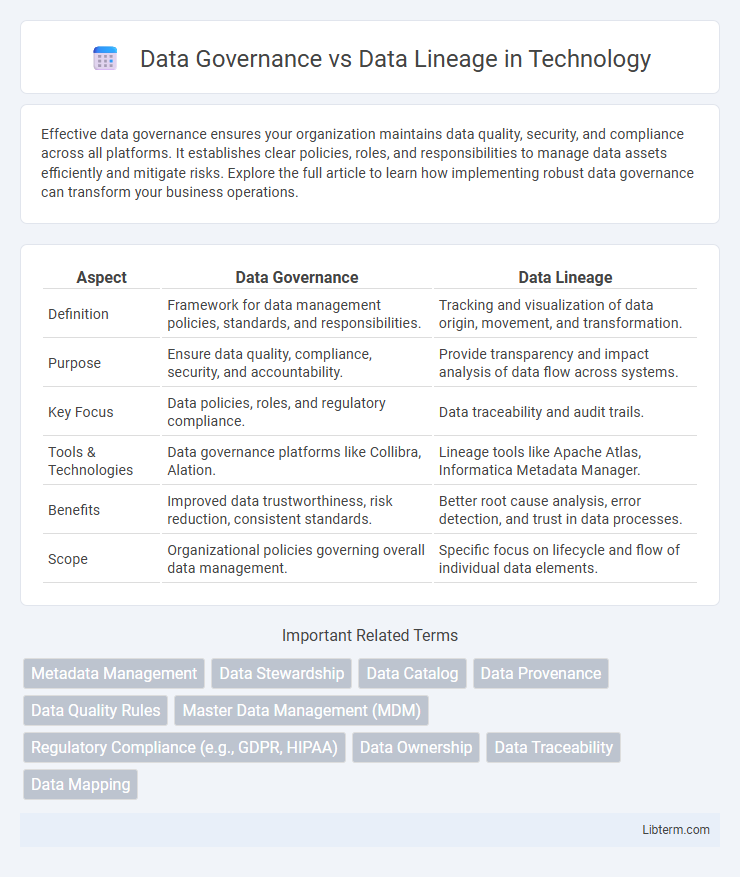Effective data governance ensures your organization maintains data quality, security, and compliance across all platforms. It establishes clear policies, roles, and responsibilities to manage data assets efficiently and mitigate risks. Explore the full article to learn how implementing robust data governance can transform your business operations.
Table of Comparison
| Aspect | Data Governance | Data Lineage |
|---|---|---|
| Definition | Framework for data management policies, standards, and responsibilities. | Tracking and visualization of data origin, movement, and transformation. |
| Purpose | Ensure data quality, compliance, security, and accountability. | Provide transparency and impact analysis of data flow across systems. |
| Key Focus | Data policies, roles, and regulatory compliance. | Data traceability and audit trails. |
| Tools & Technologies | Data governance platforms like Collibra, Alation. | Lineage tools like Apache Atlas, Informatica Metadata Manager. |
| Benefits | Improved data trustworthiness, risk reduction, consistent standards. | Better root cause analysis, error detection, and trust in data processes. |
| Scope | Organizational policies governing overall data management. | Specific focus on lifecycle and flow of individual data elements. |
Introduction to Data Governance and Data Lineage
Data Governance establishes a framework of policies, standards, and controls to ensure data quality, security, and compliance across an organization. Data Lineage tracks the flow and transformation of data from its origin to consumption, providing transparency and traceability for data assets. Together, these disciplines enable effective data management, risk mitigation, and regulatory adherence in enterprise environments.
Defining Data Governance
Data governance establishes the framework, policies, and standards necessary for managing data quality, security, and compliance within an organization. It ensures accountability by defining roles, responsibilities, and processes for data stewardship and decision-making. Effective data governance supports regulatory adherence, risk management, and the strategic use of data assets.
Understanding Data Lineage
Data lineage provides a detailed map tracking the origin, movement, and transformation of data across systems, enabling transparency and traceability within data governance frameworks. Understanding data lineage is crucial for ensuring data quality, regulatory compliance, and efficient impact analysis during data lifecycle management. It supports data governance by offering context on data provenance, helping organizations manage risks and maintain reliable decision-making processes.
Key Differences Between Data Governance and Data Lineage
Data Governance establishes the policies, standards, and accountability frameworks to manage data quality, security, and compliance across an organization, ensuring data is reliable and trustworthy. Data Lineage traces the data's origin, movement, transformation, and usage throughout its lifecycle, providing transparency and auditability for data flow analysis. The key difference lies in Data Governance defining the rules and responsibilities for data management, while Data Lineage visually maps how data travels and changes within systems.
Importance of Data Governance in Modern Organizations
Data Governance establishes a framework for managing data quality, security, and compliance, ensuring that organizational data is accurate, accessible, and protected. It provides strategic oversight to align data usage with regulatory requirements and business objectives, reducing risks and enhancing decision-making. While Data Lineage tracks the origin and transformations of data, Data Governance is crucial for maintaining trust, accountability, and consistency across all data assets in modern organizations.
The Role of Data Lineage in Data Management
Data lineage plays a critical role in data management by providing a detailed map of data flow from source to destination, ensuring transparency and traceability across complex systems. It enables organizations to track data transformations, support regulatory compliance, and enhance data quality by identifying discrepancies and inconsistencies early. Integrating data lineage within data governance frameworks strengthens data stewardship, risk management, and informed decision-making processes.
Use Cases: When to Prioritize Data Governance vs Data Lineage
Data governance should be prioritized when organizations need to establish data quality standards, compliance protocols, and accountability frameworks to manage data assets effectively. Data lineage is critical for use cases requiring detailed tracking of data flow and transformations to ensure transparency, auditability, and root cause analysis in data pipelines. Combining data governance with data lineage drives robust data management strategies, especially in regulated industries like finance, healthcare, and pharmaceuticals.
Integrating Data Governance and Data Lineage for Compliance
Integrating data governance and data lineage strengthens compliance by ensuring data accuracy, traceability, and accountability across organizational processes. Data governance provides policies and standards for data management, while data lineage maps the origin, movement, and transformation of data within systems. Together, they create a transparent framework that supports regulatory requirements such as GDPR, HIPAA, and SOX by enabling comprehensive audit trails and risk mitigation.
Best Practices for Implementing Data Governance and Data Lineage
Best practices for implementing data governance and data lineage emphasize establishing clear data ownership and accountability to ensure data quality and compliance. Utilizing automated tools to capture and visualize data lineage helps track data flow and transformations, enhancing transparency and impact analysis. Regularly updating policies and conducting training sessions promote consistent governance practices across all organizational levels.
Future Trends in Data Governance and Data Lineage
Future trends in data governance emphasize automation and AI-driven metadata management, enhancing data quality and compliance across complex ecosystems. Data lineage advancements focus on real-time tracking and visualization of data flows to improve transparency and accuracy in regulatory reporting. Integration of machine learning algorithms with governance frameworks will enable predictive analytics for proactive data risk management.
Data Governance Infographic

 libterm.com
libterm.com